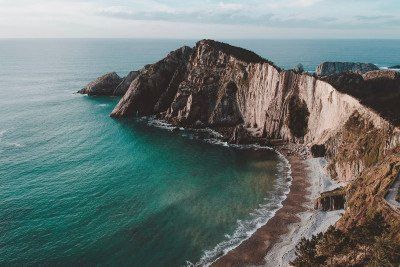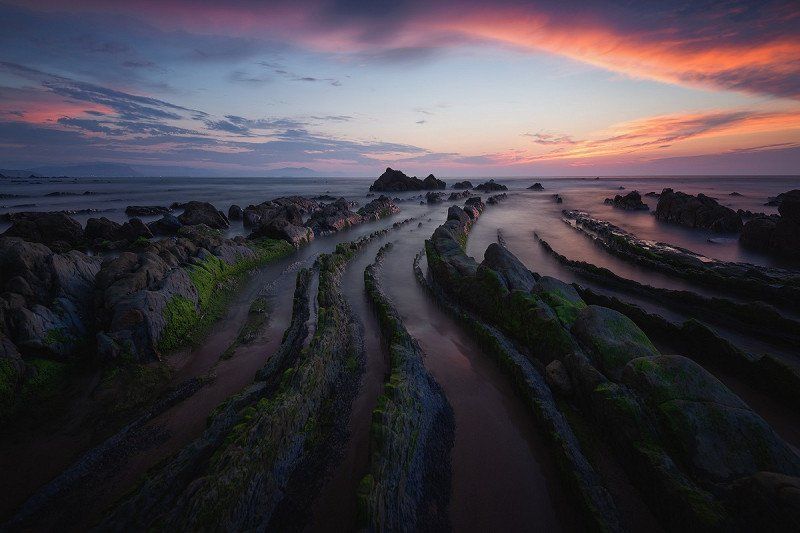Spring and autumn are the perfect time to get to know the Atlantic coast: the climate is pleasantly mild, and the summer heat and tourist hustle and bustle are either weeks away or a distant memory. Freeontour embarks on a multifaceted journey and introduces the many faces of the Atlantic coast.
Travelling through northern Spain and Portugal in a motorhome, with the sea always in view, is a real adventure. The contrast between north Spain and the rest of the country is like night and day. They both have their charm – but the north is perfect for anyone who wants to experience the country from its untamed and less touristy side. The Portuguese Atlantic coast is just as fascinating with its colourful houses, pretty towns and breathtaking landscapes.

The places we travel to have one thing in common: the Spanish and Portuguese are warm hosts and very fond of children. Nobody complains when the little ones are a little loud or cry. On the contrary – in no time at all, the kids will be holding lollipops or small gifts in their hands, which most restaurants have at the ready for their young guests. As you can see, ideal conditions for a fun family holiday. In case you and your children are or want to become avid surfers, you'll find an abundance of great spots and surf schools along the Atlantic coast.
The Basque Country – sharks, vibrant forests and picture-perfect beaches
Welcome to this northwestern corner of Spain, known for its diverse cuisine, imposing rocky landscapes, rich traditions and advanced industry. We start our trip in San Sebastián, a charming coastal town near the French border. La Concha, its wide city beach, was voted the most beautiful beach in Europe several times over the past years by the users of the travel portal TripAdvisor.

The Oma Forest and cave paintings
With delicious pintxos in our stomachs and the sun on our skin, we drive further west along the coast. It's worth taking a detour inland to Kortezubi as people of all ages can enjoy two attractions here: the Cueva de Santimamiñe cave with prehistoric cave paintings and the Oma Forest. This “enchanted forest” was created by the Spanish sculptor and painter Agustín Ibarrola who used nature as a canvas and painted vibrant patterns on the huge pine trees.
Mystical rock landscape near Barrika – Game of Thrones film location
The setting around the coastal town of Barrika is breathtaking. The rugged rock landscape consisting of layers of sand and limestone rises in strips from the sea and stretches up to the cliff (see header image above). Given this magical sight, it is not surprising that this extraordinary coastal landscape was one of the filming locations of the fantasy saga Game of Thrones.

Asturias – dinosaurs and cider on the Costa Verde
We continue travelling along the coast to Asturias, also known as Costa Verde (green coast) because of its lush landscape. The region is abundant with national parks and picture-perfect rocky bays. The picturesque coastal village of Llanes is one of the most beautiful places on the Costa Verde. Since everything can be done easily on foot – window shopping, strolling along the promenade, eating in good restaurants – Llanes is perfect for a relaxed family stay. It is also surrounded by beautiful beaches, e.g. Playa de Poo, a white sandy bay nestled between green cliffs, therefore sheltered from the sea, with crystal clear water as smooth as glass.Bees, national parks and wine bars
If you want to explore the rural life of Asturias, we recommend visiting the Aula de la Miel de los Picos de Europa honey farm in the traditional village of Alles. You can try different types of honey on the estate and learn about the amazing world of bees.

Nearby is the Picos de Europa National Park, which is partly located in the beautiful region of Cantabria. Enjoy the fascinating natural landscapes on a hiking tour. The park is home to deer, wild cats, river rats, wild birds and much more wildlife. Moreover, the Asturian forests are full of sagas and legends about the magical creatures that inhabit them. The whole of northern Spain is known for its delicious apple wine, known locally as Sidra. The city of Oviedo and its surroundings have become a Mecca for this iconic golden yellow drink, but you will also find rustic wine bars all along the coast where you can try this sweet/dry drink.

The dinosaur coast and the Jurassic Museum of Asturias in Colunga
Hardly anything fascinates children more than dinosaurs. These prehistoric giants left their traces in the truest sense of the word in Asturias – the stretch of coast between Gijón and Ribadesella is also known as the dinosaur coast as a wealth of reptile bones have been found here. Huge, amazingly well-preserved dinosaur footprints can still be seen along the coast to this day and are among the most important archaeological finds in Spain. E.g., researchers found footprints measuring 1.20 m in diameter near the Playa de la Griega beach – the second largest dinosaur footprints in the world. The dinosaur tracks along the coast are marked on information boards and are accessible to hikers. Children can also go on exciting fossil hunts. The Jurassic Museum of Asturias in Colunga is the place to go if you are interested in dinosaurs – and in keeping with the theme, it has been built in the shape of a dinosaur footprint. More than 8,000 prehistoric finds are on display here and gigantic dinosaur models as high as the ceiling tower over visitors.
Galicia - wild horses, lighthouses and pulpo at the end of the world
We continue on to Galicia, a fertile land known for its many lighthouses, boasting a landscape that is more reminiscent of Ireland than Spain. The Romans considered the rocky coast at Cape Finisterre in the most western point of the region as the end of the known world.

Galicia is also famous for its excellent fish. You should also try the legendary Galician Pulpo (squid), Caldo (soup made from white beans, potatoes and ham) and Pimientos de Padrón (peppers fried in olive oil, sometimes spicy). In addition to its traditional towns and villages, Galicia is also a paradise for nature lovers. You can still catch sight of wild horses when hiking through nature reserves, such as the Sierra de Capelada in the north of the region. A fervid hunt, the rapa de bestas, takes place between June and August when the horses are driven into the villages and sheared – needless to say, a long-standing tradition as well as a controversial custom.

The capital of the Galicia region, bearing the illustrious name of Santiago de Compostela, does not really need to be explicitly introduced. The city is known worldwide as the end point of the Way of St. James and is the destination of millions of pilgrims and tourists every year. Its proud cathedral is said to be the burial place of the apostle Saint James the Great. The medieval old town is best explored on foot and, if possible, anti-cyclically to the most popular times to visit. In the meantime, you can also relax a little. A particularly attractive bay in Galicia, for example, is the 7 km long Playa de Carnota in the west of the region. This beautiful, white, horseshoe-shaped sandy bay boasts a sea that glitters in an almost Caribbean turquoise.
"Bom dia, Porto!" - and what Harry Potter and semi-sweet wine have to do with it
We continue south and cross the border to wonderful Portugal. The enchanting city of Porto in the north of the country amazes visitors with its colourful houses, the wide Rio Douro and the many cosy port wine cellars (definitely do a tour!) where this semi-sweet wine is stored.

There are a wealth of things to see and do for families with children: feast your way through Portuguese cuisine, admire the city from the water on a boat trip on the Rio Douro, go on excursions to the bays around the city – the list is endless. One small sensation that you shouldn't withhold from your kids (nor from yourself) is a very specific book store. But this isn't any ordinary book shop – it could just as easily be a Harry Potter film set, and that's no coincidence as J.K. Rowling visited the Lello & Irmao book store during her time as an English teacher in Porto. A large part of the first Harry Potter volume was even created in these imposing halls full of bookcases, elegant stairs and splendour.
After our short Harry Potter detour, we have to get back to food and Portuguese cuisine. Try Pastel de Natas (heavenly pudding tarts), Pastéis de bacalhau (croquettes made from cod, the favourite fish of the Portuguese) and Francesinhas. The latter translates as Frenchie: a mighty ham and cheese sandwich filled with various sausages, swimming in a hearty meat and cheese sauce, definitely not for vegetarians.
Nazaré and Coimbra - giant waves and fantasy backdrops
We're slowly making our way to Lisbon – slowly because it's also worth stopping over in Nazaré and Coimbra. The former is a coastal town where extremely high waves break on the shore. Accordingly, surfing world records are set here regularly. If you want to know more about Nazaré, read on here.Coimbra should also be on the itinerary of every Harry Potter and fantasy fan. It is one of the oldest university towns in Europe and the students wear school uniforms that could also have come from J.K. Rowling's novels. The city also has a lively bar and restaurant scene. And thanks to the small size of the old town, Coimbra is perfect for exploring on foot. Details on sights in Coimbra can be found here .

Lisbon - colorful charm and crazy tram rides
Lisbon is undoubtedly one of those cities that you have to have visited at least once in your lifetime. This is the place to be if you're interested in food and culture. Moreover, the Portuguese capital is overflowing with charm thanks to its asphalted hills, typical trams and colourful, at times very old, houses. You can't leave Lisbon without having ridden on the historic no. 28 tram, which will take you to and through the most interesting areas of the city. It gets pretty adventurous when it drives through incredibly narrow streets. Or if you want to explore the city in a fun way with fewer people, take a rickshaw.

Located at the mouth of the Tagus River, Torre de Belém (Belém Tower) is also worth a visit. It is one of the city's most important landmarks and one of the few buildings that survived the Great Lisbon Earthquake in 1755. There is a viewing platform on the upper floor of the 35 m high tower. From 1521 onwards, it served as an imposing lighthouse, welcoming explorers and merchant ships to the city. The Time Out Market is a magical experience for the palate. This lively and ultra-modern market hall has numerous stalls, small restaurants and cafés where you can try the local cuisine.

